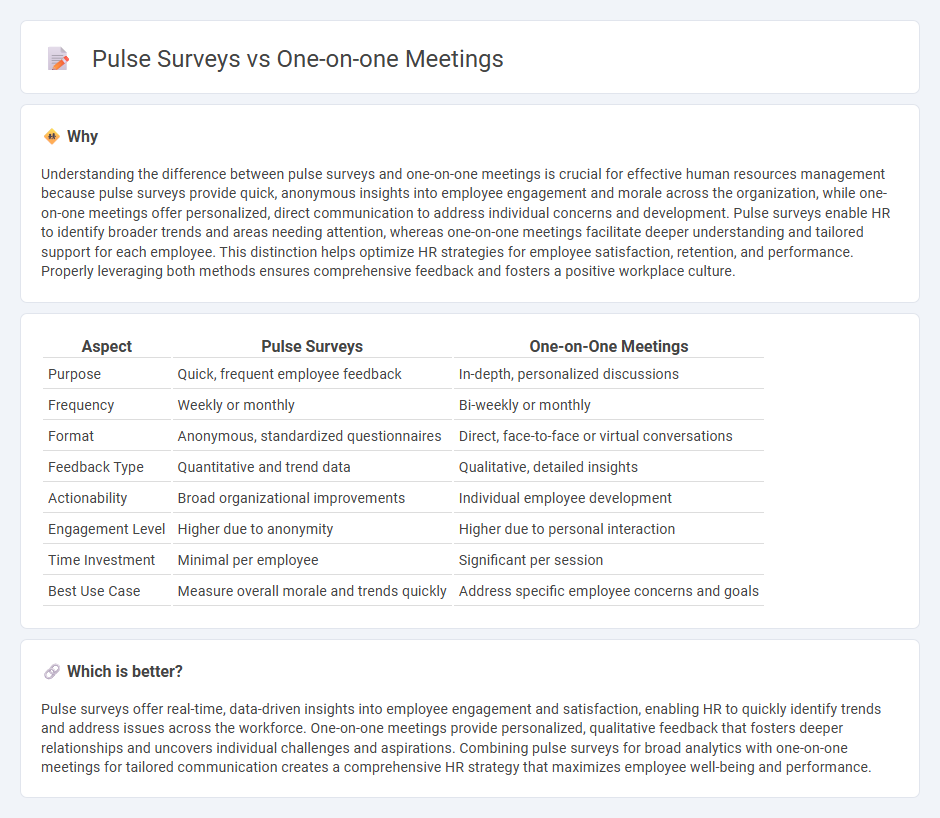
Pulse surveys provide frequent, data-driven insights into employee engagement and sentiment, enabling HR teams to quickly identify trends and address issues. One-on-one meetings offer personalized, in-depth conversations that foster trust and allow for tailored feedback and development. Explore the benefits of integrating both methods to enhance organizational communication and employee satisfaction.
Why it is important
Understanding the difference between pulse surveys and one-on-one meetings is crucial for effective human resources management because pulse surveys provide quick, anonymous insights into employee engagement and morale across the organization, while one-on-one meetings offer personalized, direct communication to address individual concerns and development. Pulse surveys enable HR to identify broader trends and areas needing attention, whereas one-on-one meetings facilitate deeper understanding and tailored support for each employee. This distinction helps optimize HR strategies for employee satisfaction, retention, and performance. Properly leveraging both methods ensures comprehensive feedback and fosters a positive workplace culture.
Comparison Table
| Aspect | Pulse Surveys | One-on-One Meetings |
|---|---|---|
| Purpose | Quick, frequent employee feedback | In-depth, personalized discussions |
| Frequency | Weekly or monthly | Bi-weekly or monthly |
| Format | Anonymous, standardized questionnaires | Direct, face-to-face or virtual conversations |
| Feedback Type | Quantitative and trend data | Qualitative, detailed insights |
| Actionability | Broad organizational improvements | Individual employee development |
| Engagement Level | Higher due to anonymity | Higher due to personal interaction |
| Time Investment | Minimal per employee | Significant per session |
| Best Use Case | Measure overall morale and trends quickly | Address specific employee concerns and goals |
Which is better?
Pulse surveys offer real-time, data-driven insights into employee engagement and satisfaction, enabling HR to quickly identify trends and address issues across the workforce. One-on-one meetings provide personalized, qualitative feedback that fosters deeper relationships and uncovers individual challenges and aspirations. Combining pulse surveys for broad analytics with one-on-one meetings for tailored communication creates a comprehensive HR strategy that maximizes employee well-being and performance.
Connection
Pulse surveys provide real-time insights into employee engagement and satisfaction, enabling HR professionals to identify key issues and trends quickly. One-on-one meetings complement these surveys by facilitating personalized feedback and deeper conversations, allowing managers to address specific concerns raised in the survey data. This combination strengthens communication channels, improves employee experience, and drives targeted actions for workforce optimization.
Key Terms
Feedback
One-on-one meetings provide personalized, real-time feedback allowing managers to address individual concerns and foster stronger employee relationships. Pulse surveys gather anonymous, data-driven insights from a broader employee base to identify trends and improve organizational culture. Explore how combining both methods can enhance your feedback strategy and drive continuous improvement.
Engagement
One-on-one meetings provide personalized feedback and foster direct communication, enhancing employee engagement through tailored support and real-time problem-solving. Pulse surveys capture broader workforce sentiments frequently and efficiently, offering data-driven insights into engagement trends across teams. Explore more to determine which method best boosts your organization's engagement strategy.
Communication
One-on-one meetings provide personalized communication, allowing managers to address individual employee concerns and foster trust through direct dialogue. Pulse surveys gather real-time feedback from a broad workforce, enabling quick identification of trends and issues across teams. Explore deeper insights on how these tools enhance workplace communication strategies.
Source and External Links
Effective one-on-one meetings: Free template and agenda - Asana - One-on-one meetings are dedicated sessions between a manager and an employee focused on open communication, personalized feedback, professional growth, and building trust that boost employee engagement and alignment with company goals.
One on One Meetings with Employees: The Complete Guide - Qualtrics - Best practices for one-on-ones include setting an agenda with employee input, conducting thorough well-being check-ins, reviewing workload balance, and discussing personal development to ensure meaningful and effective conversations.
Manager Best Practices: One-on-One Meetings | Human Resources - One-on-ones should be regularly scheduled, employee-driven meetings lasting around 30 minutes, used to surface issues, maintain two-way communication, track goals, provide feedback, and significantly increase employee engagement and trust.
 dowidth.com
dowidth.com